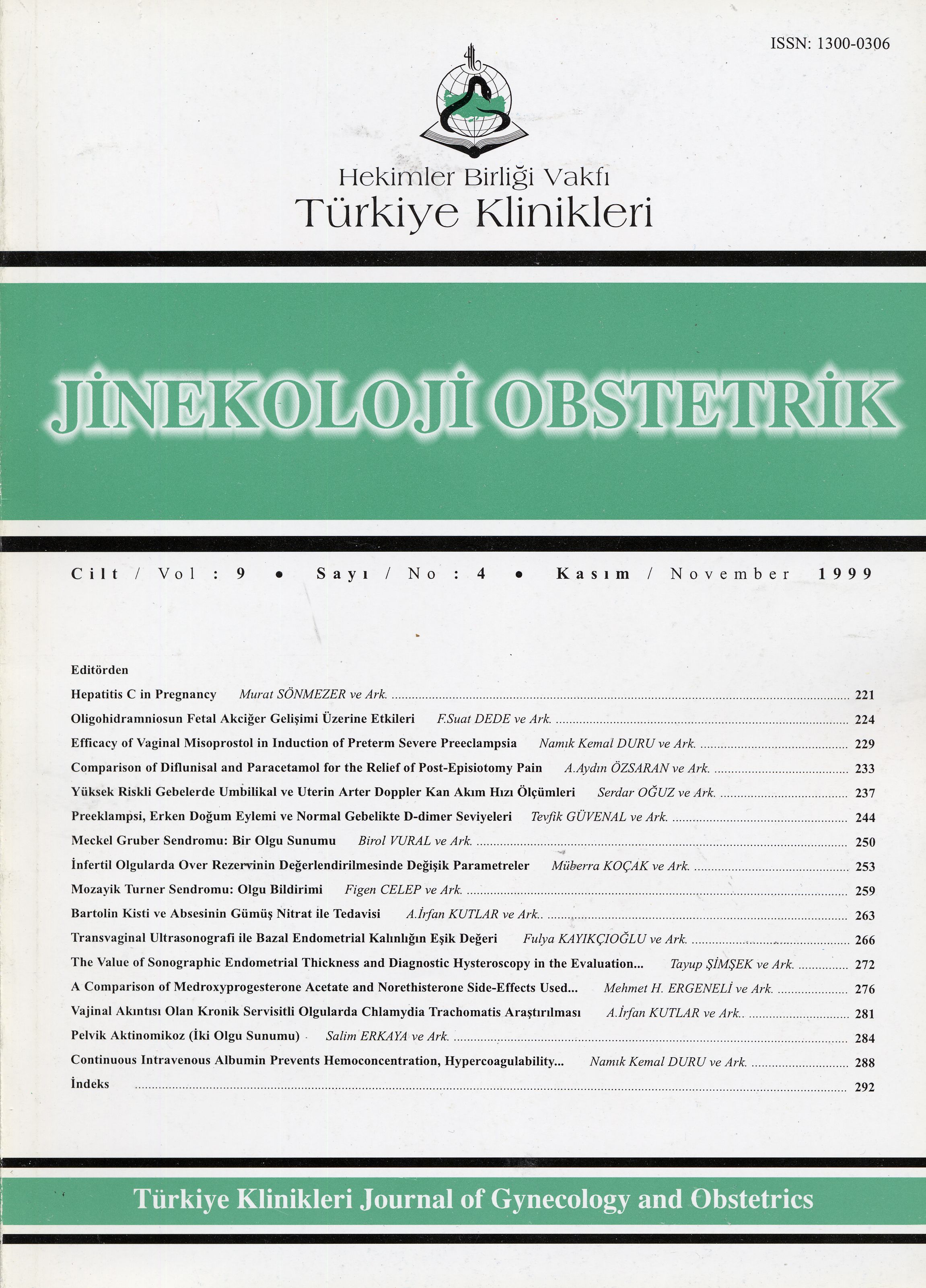Open Access
Peer Reviewed
ARTICLES
7862 Viewed13024 Downloaded
The Treatment Of Bartholin's Cyst And Abscess With Silver Nitrate
Bartolin Kisti ve Absesinin Gümüş Nitrat ile Tedavisi
Turkiye Klinikleri J Gynecol Obst. 1999;9(4):263-5
Article Language: TR
Copyright Ⓒ 2025 by Türkiye Klinikleri. This is an open access article under the CC BY-NC-ND license (http://creativecommons.org/licenses/by-nc-nd/4.0/)
ÖZET
Amaç: Bartolin kist ve abselerinin tedavisinde gümüş nitrat kullanımının etkinliğini araştırmak. Araştırmanın Yapıldığı Yer: Zübeyde Hanım Doğumevi, Ankara Materyal Metod: Bartolin kisti tanısıyla 13, Bartolin absesi tanısıyla 18, toplam 31 hasta üzerinde çalışma yapıldı. Direne edilen abse ve kist boşluklarına 0,5 cm lik gümüş nitrat kalemi parçası yerleştirildi. Bulgular: İşlemden 24-32 saat sonra 30 vakada kist duvarı tam olarak çıkarıldı, 1 olguda venöz kanama, 1 olguda şimik deri ülserasyonu oldu. 1 vakada 2. ayda nüks oluştu. 6. ayda kontrollerde nüks görülmedi. Yorum: Bartolin kist ve abselerinin tedavisinde gümüş nitrat uygulaması kolay, komplikasyonu düşük, oldukça ucuz, hastanede yatış süresini kısaltan, başarı oranı yüksek bir yöntemdir.
Amaç: Bartolin kist ve abselerinin tedavisinde gümüş nitrat kullanımının etkinliğini araştırmak. Araştırmanın Yapıldığı Yer: Zübeyde Hanım Doğumevi, Ankara Materyal Metod: Bartolin kisti tanısıyla 13, Bartolin absesi tanısıyla 18, toplam 31 hasta üzerinde çalışma yapıldı. Direne edilen abse ve kist boşluklarına 0,5 cm lik gümüş nitrat kalemi parçası yerleştirildi. Bulgular: İşlemden 24-32 saat sonra 30 vakada kist duvarı tam olarak çıkarıldı, 1 olguda venöz kanama, 1 olguda şimik deri ülserasyonu oldu. 1 vakada 2. ayda nüks oluştu. 6. ayda kontrollerde nüks görülmedi. Yorum: Bartolin kist ve abselerinin tedavisinde gümüş nitrat uygulaması kolay, komplikasyonu düşük, oldukça ucuz, hastanede yatış süresini kısaltan, başarı oranı yüksek bir yöntemdir.
ANAHTAR KELİMELER: Bartolin kisti, Bartolin absesi, Gümüş nitrat
ABSTRACT
Objective: To investigate the effectiveness of silver nitrate insertion in the treatment of Bartolins cysts and abcess. Instution: Zübeyde Hanım Maternity Hospital, Ankara Materials and Methods: Totaly 31 patients, of which 13 with Bartholins cysts and 18 with Bartholins abcess were included in this study. Following the drainage of the cysts and abcess, silver nitrate in pieces of 0,5 cm inserted in the gland. Results: Following insertion procedure, cyst walls were enuclated completely in 30 patients after 24-32 hours. Among the complications; venous bleeding in one case and chemical skin ulceration in the other case were observed. Recurrence of the abcess was noted only in one patient following 2 months after the procedure. No cases of recurrences could be demostrated during 6 months follow-up evaluation.
Objective: To investigate the effectiveness of silver nitrate insertion in the treatment of Bartolins cysts and abcess. Instution: Zübeyde Hanım Maternity Hospital, Ankara Materials and Methods: Totaly 31 patients, of which 13 with Bartholins cysts and 18 with Bartholins abcess were included in this study. Following the drainage of the cysts and abcess, silver nitrate in pieces of 0,5 cm inserted in the gland. Results: Following insertion procedure, cyst walls were enuclated completely in 30 patients after 24-32 hours. Among the complications; venous bleeding in one case and chemical skin ulceration in the other case were observed. Recurrence of the abcess was noted only in one patient following 2 months after the procedure. No cases of recurrences could be demostrated during 6 months follow-up evaluation.
MENU
POPULAR ARTICLES
MOST DOWNLOADED ARTICLES





This journal is licensed under a Creative Commons Attribution-NonCommercial-NoDerivatives 4.0 International License.










